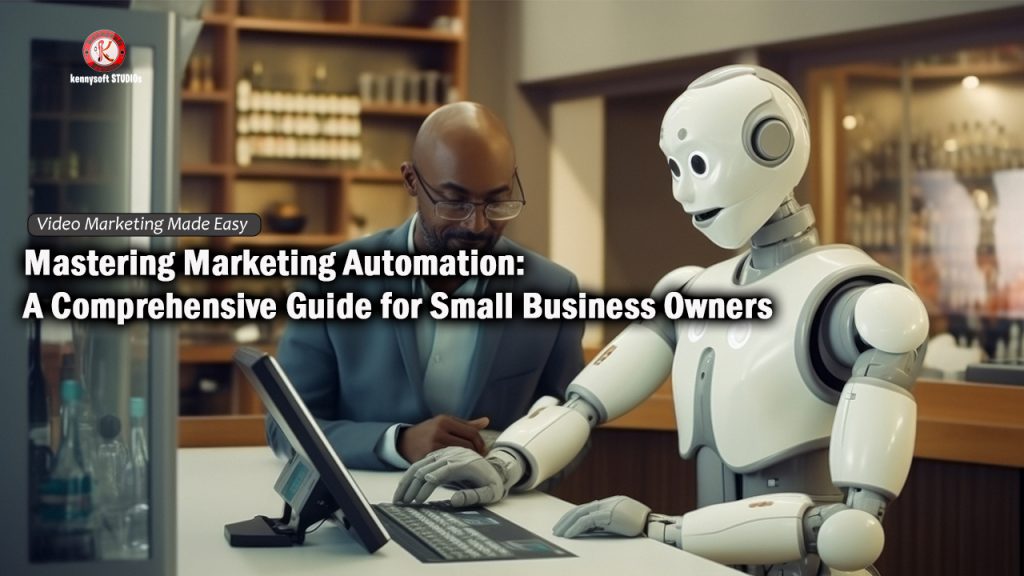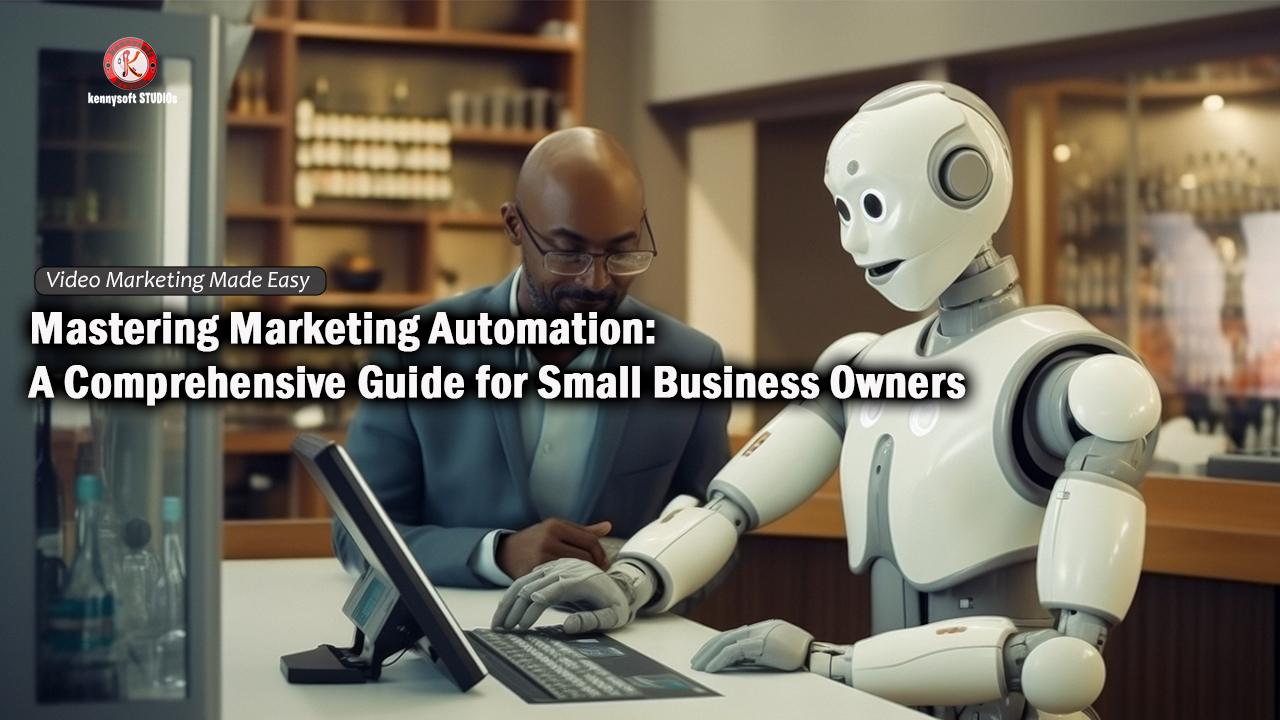
As a small business owner, maximizing your marketing efforts with limited resources is crucial for sustainable growth. Marketing automation offers a powerful solution, allowing you to achieve better results while freeing valuable time and resources. This comprehensive guide will delve deep into various aspects of marketing automation, providing actionable insights and strategies to help your small business thrive.
- Key Areas for Marketing Automation
- 1. Email Marketing Automation: Nurturing Leads and Driving Conversions
- a) Welcome Sequences:
- b) Abandoned Cart Reminders:
- c) Behavioral Triggers:
- d) Lifecycle Marketing:
- 2. Social Media Automation: Maintaining Consistent Engagement
- a) Content Scheduling:
- b) Social Listening and Engagement:
- c) User-Generated Content (UGC) Curation:
- d) Cross-Platform Posting:
- a) Lead Scoring and Qualification:
- b) Automated Follow-ups:
- c) Integration with Other Tools:
- d) Reporting and Analytics:
- 3. Content Marketing Automation: Streamlining Creation and Distribution
- a) Content Ideation and Planning:
- b) Content Creation:
- c) Content Distribution:
- d) Content Performance Tracking:
- 4. Advertising Automation: Maximizing ROI on Paid Campaigns
- a) Automated Bidding Strategies:
- b) Dynamic Ads:
- c) Ad Testing and Optimization:
- d) Cross-Channel Advertising:
- 5. Marketing Analytics Automation: Data-Driven Decision Making
- b) Multi-Channel Data Integration:
- c) Predictive Analytics:
- d) Conversion Rate Optimization (CRO):
- 6. Customer Feedback and Reputation Management Automation
- a) Automated Surveys:
- b) Review Management:
- c) Reputation Monitoring:
- d) Customer Feedback Analysis:
- Choosing the Right Tools
- Implementing Marketing Automation
- Overcoming Common Challenges
- Real-Life Success Stories
- Conclusion
Understanding Marketing Automation
Marketing automation refers to the use of software and technology to automate repetitive marketing tasks, such as email marketing, social media posting, and ad campaigns. This not only saves time but also ensures consistency and precision in marketing activities. By leveraging marketing automation tools, small business owners can focus on strategic decision-making and customer engagement.
Benefits of Marketing Automation
- Time Savings: Automating repetitive tasks frees up valuable time for business owners and their teams to focus on core activities.
- Consistency: Automated marketing ensures that messages are sent out regularly and consistently, maintaining a steady presence in front of customers.
- Personalization: Automation tools can segment audiences and tailor messages to individual preferences, enhancing customer experience and engagement.
- Scalability: As businesses grow, marketing automation can scale with them, handling larger volumes of tasks without additional resources.
Data-Driven Insights: Automation tools provide analytics and insights that help businesses make informed decisions and optimize their marketing strategies

Key Areas for Marketing Automation
1. Email Marketing Automation: Nurturing Leads and Driving Conversions
Email marketing remains one of the most effective channels for small businesses, boasting an impressive ROI. Here’s how to leverage automation to take your email campaigns to the next level:
a) Welcome Sequences:
- Create a series of 3-5 emails introducing new subscribers to your brand
- Include valuable content, product highlights, and exclusive offers
- Personalize messages based on signup source or initial interests
b) Abandoned Cart Reminders:
- Set up a sequence of 2-3 emails sent over 24-72 hours after cart abandonment
- Include product images, reviews, and a clear call-to-action
- Experiment with offering incentives in later emails (e.g., free shipping, small discount)
c) Behavioral Triggers:
- Implement emails based on specific user actions (e.g., viewing a product, downloading a resource)
- Create segmented lists based on engagement levels and interests
- Develop targeted content for each segment to improve relevance
d) Lifecycle Marketing:
- Map out your customer journey and create automated campaigns for each stage
- Include onboarding sequences, up-sell opportunities, and re-engagement campaigns
- Use dynamic content to personalize emails based on customer data
Tools like ActiveCampaign, Drip, or Klaviyo offer advanced automation features suitable for growing businesses.
2. Social Media Automation: Maintaining Consistent Engagement
Social media is vital for brand awareness and customer engagement. Here’s how to automate your social media efforts effectively:
a) Content Scheduling:
- Use tools like Sprout Social or Agorapulse to plan and schedule content weeks in advance
- Create a content calendar aligning with your marketing goals and seasonal events
- Mix promotional content with educational and entertaining posts for better engagement
b) Social Listening and Engagement:
- Set up automated alerts for brand mentions and relevant keywords
- Use chatbots on platforms like Facebook Messenger for initial customer inquiries
- Implement tools like Mention or Brand24 for comprehensive social listening
c) User-Generated Content (UGC) Curation:
- Use tools like Stackla or Yotpo to automatically collect and display UGC
- Set up hashtag tracking to find and reshare customer posts
- Implement automated permission requests for using UGC in your marketing
d) Cross-Platform Posting:
- Utilize tools that allow simultaneous posting across multiple platforms
- Adjust content format and messaging to suit each platform’s unique characteristics
- Analyze cross-platform performance to optimize your strategy
- Customer Relationship Management (CRM) Automation: Streamlining Customer Interactions
A well-implemented CRM system can transform how you manage customer relationships:
a) Lead Scoring and Qualification:
- Develop a points-based system to score leads based on demographics and behaviors
- Set up automated alerts for sales team when leads reach a certain score threshold
- Implement progressive profiling to gather more data over time without overwhelming prospects
b) Automated Follow-ups:
- Create email sequences for different stages of the sales funnel
- Set up task reminders for sales team based on lead interactions
- Implement automated check-ins for existing customers to maintain relationships
c) Integration with Other Tools:
- Connect your CRM with your email marketing platform for seamless data flow
- Integrate with your customer service software to provide a 360-degree view of customer interactions
- Link your CRM to your e-commerce platform for better order tracking and customer insights
d) Reporting and Analytics:
- Set up automated weekly or monthly reports on key metrics
- Create customized dashboards for different team members
- Implement predictive analytics to forecast sales and identify at-risk customers
Consider options like Pipedrive, Salesforce Essentials, or Zoho CRM for robust automation features.

3. Content Marketing Automation: Streamlining Creation and Distribution
Content marketing is a powerful way to attract and retain customers. Here’s how to automate various aspects:
a) Content Ideation and Planning:
- Use tools like BuzzSumo or SEMrush to identify trending topics in your industry
- Implement keyword research tools to find high-potential content ideas
- Set up Google Alerts for industry news to inspire timely content
b) Content Creation:
- Use AI writing assistants like Jasper.ai or Copy.ai for content outlines and first drafts
- Implement grammar and style checkers like Grammarly for consistent quality
- Use tools like Canva or Crello with templates for quick visual content creation
c) Content Distribution:
- Set up RSS-to-social tools to automatically share new blog posts
- Use content syndication platforms to reach wider audiences
- Implement email digests to share your latest content with subscribers
d) Content Performance Tracking:
- Set up automated content performance reports in Google Analytics
- Use tools like Hotjar to track user engagement with your content
- Implement A/B testing tools to optimize headlines and content formats
4. Advertising Automation: Maximizing ROI on Paid Campaigns
Paid advertising can deliver quick results, but it requires careful management. Here’s how to automate your ad efforts:
a) Automated Bidding Strategies:
- Utilize machine learning-powered bidding on platforms like Google Ads and Facebook Ads
- Experiment with different strategies (e.g., target CPA, maximize conversions) based on your goals
- Regularly review and adjust your automated bidding settings for optimal performance
b) Dynamic Ads:
- Set up dynamic product ads that automatically update based on your inventory
- Use retargeting campaigns to show personalized ads based on user behavior
- Implement dynamic creative optimization to test different ad elements automatically
c) Ad Testing and Optimization:
- Use tools like AdEspresso or Revealbot for automated A/B testing of ad creatives
- Set up rules for automatic budget allocation based on ad performance
- Implement automated alerts for significant changes in ad performance metrics
d) Cross-Channel Advertising:
- Use tools like Adext AI to automatically manage and optimize ads across multiple platforms
- Implement cross-channel attribution models to understand the full customer journey
- Set up automated rules to adjust budgets across channels based on performance

5. Marketing Analytics Automation: Data-Driven Decision Making
Effective marketing relies on data. Here’s how to automate your analytics processes:
a) Reporting Automation:
- Set up automated weekly or monthly reports in Google Analytics and other platforms
- Use data visualization tools like Tableau or Google Data Studio for interactive dashboards
- Implement automated anomaly detection to quickly identify unusual trends
b) Multi-Channel Data Integration:
- Use tools like Supermetrics or Funnel.io to aggregate data from various marketing channels
- Set up automated data pipelines to consolidate information in a central location
- Implement data cleansing and normalization processes for consistent reporting
c) Predictive Analytics:
- Utilize machine learning tools to forecast future trends and performance
- Implement churn prediction models to identify at-risk customers
- Use predictive lead scoring to prioritize sales efforts
d) Conversion Rate Optimization (CRO):
- Set up automated A/B testing tools like Optimizely or VWO
- Implement heat mapping and session recording tools for continuous UX insights
- Use tools like Google Optimize for personalized website experiences
6. Customer Feedback and Reputation Management Automation
Understanding and managing your customers’ experiences is crucial. Here’s how to automate these processes:
a) Automated Surveys:
- Set up post-purchase surveys to gather immediate feedback
- Implement Net Promoter Score (NPS) surveys at regular intervals
- Use tools like SurveyMonkey or Typeform for automated survey distribution and analysis
b) Review Management:
- Use tools like Yotpo or Trustpilot to automatically request reviews after purchases
- Set up alerts for new reviews across various platforms (Google, Yelp, etc.)
- Implement sentiment analysis tools to gauge overall customer satisfaction trends
c) Reputation Monitoring:
- Use brand monitoring tools to track mentions across the web
- Set up automated alerts for significant changes in sentiment or volume of mentions
- Implement tools like Mention or Brandwatch for comprehensive reputation tracking
d) Customer Feedback Analysis:
- Use text analysis tools to categorize and summarize open-ended feedback
- Implement automated tagging of customer support tickets for trend analysis
- Set up regular reports summarizing key themes in customer feedback
Choosing the Right Tools
Selecting the right automation tools is crucial for success. Consider the following factors:
- Ease of Use: Choose tools that are user-friendly and require minimal training.
- Integration: Ensure the tools can integrate with your existing systems and platforms.
- Scalability: Opt for tools that can grow with your business needs.
- Cost: Evaluate the cost of the tools relative to the value they provide and your budget constraints.
- Support: Look for tools that offer robust customer support and resources.
Implementing Marketing Automation
- Define Goals: Clearly outline your marketing goals and objectives to guide your automation strategy.
- Start Small: Begin with a few key tasks and gradually expand your automation efforts.
- Train Your Team: Provide training and resources to your team to ensure they can effectively use the automation tools.
- Monitor and Adjust: Continuously monitor the performance of automated tasks and make necessary adjustments to optimize results.
Overcoming Common Challenges
- Initial Setup: The initial setup of automation tools can be time-consuming. Allocate sufficient time and resources to set up and configure the tools correctly.
- Learning Curve: There may be a learning curve associated with new tools. Invest in training and support to help your team get up to speed.
- Data Management: Ensure you have a strategy for managing and maintaining clean, accurate data to fuel your automation efforts.
Real-Life Success Stories
To illustrate the impact of marketing automation, consider these real-life success stories:
- Jumia Nigeria: A Nigerian e-commerce business used email automation to segment their audience and send personalized product recommendations. As a result, their email open rates increased by 30%, and sales grew by 20%.
- kilimanjaro restaurant: A local restaurant leveraged social media scheduling tools to maintain a consistent online presence. This led to a 25% increase in social media followers and a significant boost in customer engagement.
- KENNYSOFT DIGITAL: A service-based business implemented a CRM system to automate lead nurturing and follow-ups. They saw a 40% improvement in lead conversion rates and a more streamlined sales process.
Conclusion
By implementing these detailed automation strategies, small business owners can significantly enhance their marketing efforts, compete more effectively with larger companies, and drive sustainable growth. Remember to start with the areas that align most closely with your business goals, test and refine your approaches, and gradually expand your automation efforts as you see results.
As you embark on your marketing automation journey, keep in mind that while automation can greatly improve efficiency and effectiveness, the human touch remains crucial. Use automation to handle repetitive tasks and data analysis, freeing up your time to focus on strategy, creativity, and building genuine connections with your customers.






